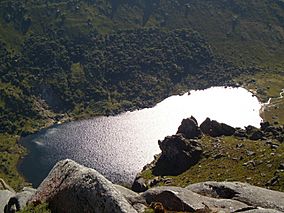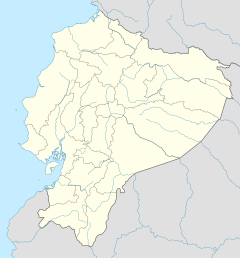Yacurí National Park facts for kids
Quick facts for kids Yacurí National Park |
|
|---|---|
| Parque Nacional Yacurí | |
|
IUCN Category II (National Park)
|
|

Laguna Negra ("black lake"), Yacurí National Park
|
|
| Location | Zamora Chinchipe and Loja, Ecuador |
| Nearest city | Amaluza |
| Area | 431 km2 (166 sq mi) |
| Established | 2009 |
Yacurí National Park (which means Parque Nacional Yacurí in Spanish) is a special protected area in Ecuador. It covers about 431 square kilometers (166 square miles). This park is located right on the border between two provinces: Loja and Zamora Chinchipe.
Yacurí National Park was created in 2009. It is part of a much larger protected forest area. The park is very important because it contains the starting points for two major river systems. These are the Chinchipe-Mayo rivers in the east and the Catamayo-Chira rivers in the west.
Contents
What Plants Grow in Yacurí National Park?
Yacurí National Park is home to many different types of natural environments. These environments help various plants to grow. Most of the park is covered by a few main types of plant areas.
Types of Plant Environments
- Southern Andean Shrub Páramo: This type of land has many shrubs and is found in the southern Andes mountains. It makes up about 42.6% of the park.
- Eastern Andean Upper Montane Evergreen Forest: These are forests with trees that stay green all year. They are found high up in the eastern Andes and cover about 22% of the park.
- Southern Andean Dry Montane Shrubland: This is a drier area with shrubs in the southern Andes. It covers about 15.1% of the park.
- Eastern Andean Cloud Forest: These are misty forests high in the eastern Andes. Clouds often cover them, and they make up about 14% of the park.
Amazing Plant Life and Conservation
The park has an incredible variety of plants. Scientists have found 280 different kinds of plant species here. What's even more amazing is that 32 of these plants are endemic to the park. This means they are found nowhere else in the world!
Unfortunately, some of these plants are in danger. Two species are currently endangered, meaning they are at high risk of disappearing forever. Another 11 species are considered vulnerable, which means they could become endangered if we don't protect them.
What Animals Live in Yacurí National Park?
Yacurí National Park is a safe home for many different animals. It is especially important for protecting species that are rare or endangered.
Mammals of the Park
There are 18 different kinds of mammals living in the park. Five of these mammal species are endangered, which means they need special protection. Some of the important mammals you might find include:
- Cougar: Also known as a puma, this large wild cat is considered vulnerable.
- Mountain Tapir: This unique animal looks a bit like a pig with a short trunk. It is an endangered species.
- Spectacled Bear: This is the only bear species found in South America. It is also an endangered animal.
Birds and Amphibians
The park is also a great place for birdwatching, with 111 different bird species. Four of these bird species are endangered. In addition, there are 11 types of amphibians, like frogs and salamanders. Four of these amphibian species are also endangered.
Fun Things to See and Do in Yacurí National Park
Yacurí National Park is not just for protecting nature; it also has many amazing places to visit! The park is famous for its beautiful high-altitude lakes. There are over 46 of these lakes scattered throughout the park.
Popular Lakes to Explore
- Laguna Negra (Black Lake): This lake is very deep and sits inside an old, inactive volcano. People believe its waters have healing powers. Local traditional healers often visit it. You can reach Laguna Negra with a 50-minute hike from a nearby shelter. From the lake, you can even try to reach the highest peak in Loja, though there isn't a clear path.
- Laguna Yacurí: This is the biggest lake in the park and is where the park gets its name. It's a longer hike to get here, about five hours. The trail starts from a road that goes from the town of Espindola towards the park.
Ancient History on the Inca Trail
The famous Inca Trail also passes through Yacurí National Park. This ancient trail was built by the Inca people long ago. Along the western side of the park, you can find interesting archaeological sites. These include old rock carvings (petroglyphs), ancient plazas, and even old cemeteries. It's like stepping back in time to see how people lived centuries ago!
See also
 In Spanish: Parque nacional Yacurí para niños
In Spanish: Parque nacional Yacurí para niños


